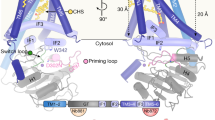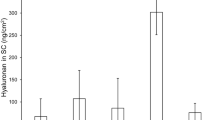Abstract
AN unsolved problem in the study of rheumatic diseases is whether or not hyaluronidase plays any part in the typical changes in the connective tissue, particularly of the interfibrillar cement substance, which is believed to contain hyaluronic acid. Guerra1, for example, claimed that sodium salicylate significantly inhibits the spreading power of hyaluronidase injected into the skin, and therefore ascribed the value of salicylate in rheumatic fever to an action of the drug on the hyaluronidase–hyaluronic acid system of the body. Meyer2 and Dorfman et al.3 confirmed these observations, but gave no experimental data. Later, Meyer and Ragan4 argued that the effect claimed by Guerra was due not to the salicylate but to gentisate, a supposed metabolic product of salicylate. Further research has since shown that therapeutic concentrations of salicylate5,6 or gentisate7 are too weak to inhibit hyaluronidase in vitro. Moreover, Swyer6, Dalgaard-Mikkelsen8 and Jones9 failed to find any demonstrable effect of salicylate on the spreading activity of hyaluronidase injected into the rabbit's skin. The evidence is thus contradictory and too weak to ascribe the value of salicylate in rheumatic fever to an inhibition of hyaluronidase.
This is a preview of subscription content, access via your institution
Access options
Subscribe to this journal
Receive 51 print issues and online access
$199.00 per year
only $3.90 per issue
Buy this article
- Purchase on Springer Link
- Instant access to full article PDF
Prices may be subject to local taxes which are calculated during checkout
Similar content being viewed by others
References
Guerra, F., J. Pharm. Exp. Therapeutics, 87, 193 (1946).
Meyer, K., Physiol. Rev., 27, 335 (1947).
Dorfman, A., Reimers, E. J., and Ott, M. L., Proc. Soc. Exp. Biol. Med., 64, 357 (1947).
Meyer, K., and Ragan, Ch., Science, 108, 281 (1948).
Pike, R. M., Science, 105, 391 (1947). Fabinyi, M., Klein, E., and Szebehely, J., Arch. int. pharmacodyn. ther., 77, 270 (1948).
Swyer, G. I. M., Biochem. J., 42, 28 (1948).
Lowenthal, J., and Gagnon, A., Canad. J. Res., 26, 200 (1948).
Dalgaard-Mikkelsen, S., “Experimentelle Undersøgelser over Salicylsyrens Farmakologi” (Copenhagen, 1949).
Jones, E. S., Ann. Rheum. Dis., 9, 137 (1950).
Hahn, L., and Fekete, J. (in the press). Hahn, L., and Frank, E. (in the press).
Fabinyi-Szebehely, M., Hahn, L., and Szebehely, J. (to be published).
Thune, S., and Truedsson, E. (to be published).
Author information
Authors and Affiliations
Rights and permissions
About this article
Cite this article
HAHN, L. Inhibitors of Hyaluronidase. Nature 170, 282–283 (1952). https://doi.org/10.1038/170282b0
Issue Date:
DOI: https://doi.org/10.1038/170282b0
This article is cited by
-
In silico evaluation of antimicrobial, antihyaluronidase and bioavailability parameters of rosmarinic acid in Perilla frutescens leaf extracts
SN Applied Sciences (2020)
-
Enzyme Inhibition
Nature (1954)
Comments
By submitting a comment you agree to abide by our Terms and Community Guidelines. If you find something abusive or that does not comply with our terms or guidelines please flag it as inappropriate.



